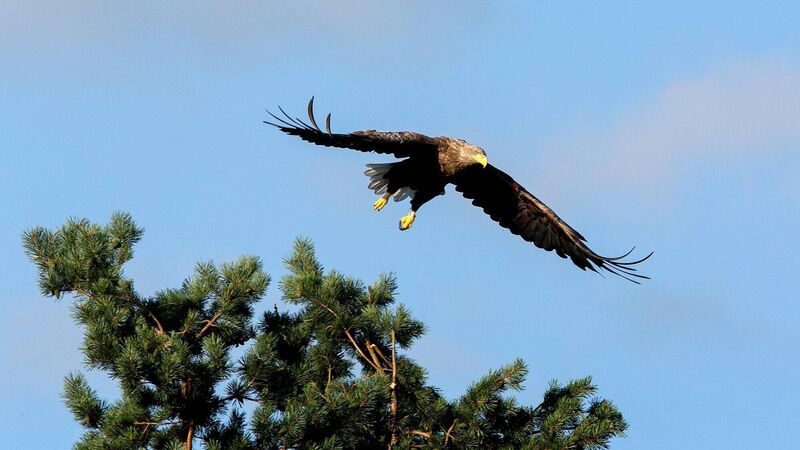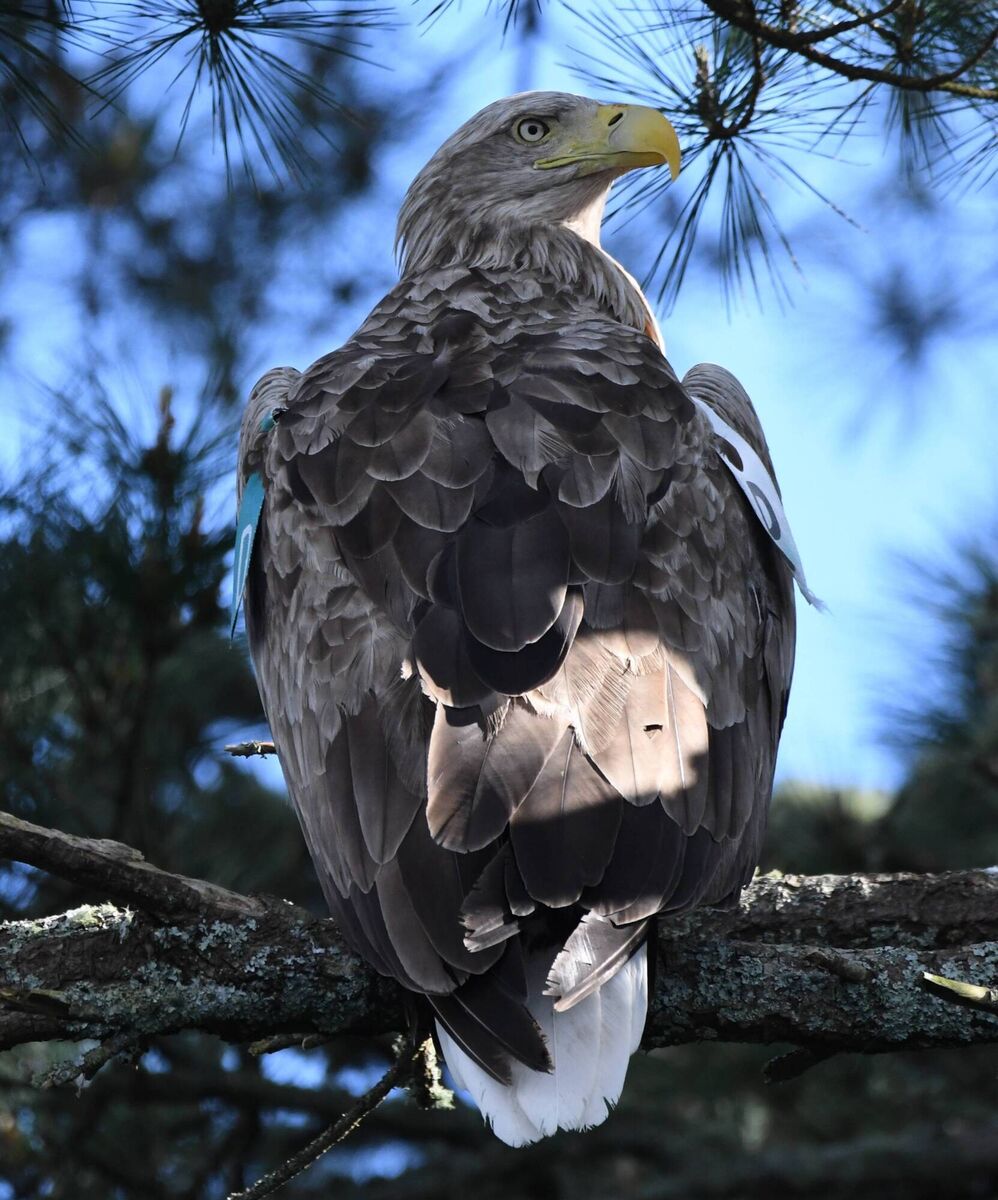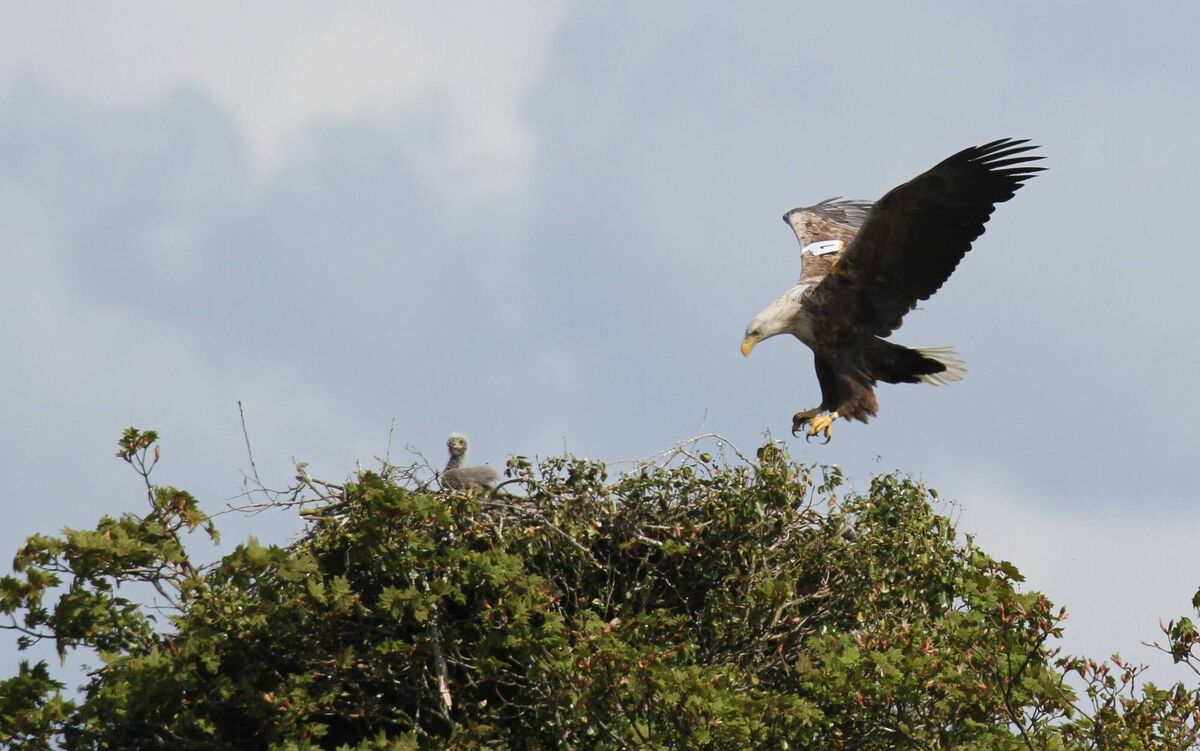Anja Murray: Breeding season begins for Ireland's majestic white-tailed sea eagles

A male white-tailed eagle seen at Mountshannon, Co. Clare. Picture: Arthur English
White-tailed sea eagles are the largest bird of prey in Ireland. Their outstretched wings can span two-and-a-half metres, earning them the description of a ‘flying barn door’. Seeing one of these powerful apex predators swoop through the air is an exhilarating experience. My one experience of seeing them, near Glengarriff in west Cork, was an experience I’ll never forget.
For thousands of years, both golden eagles and the white-tailed sea eagles were widespread here. Way back in Mesolithic times, we know that people held eagles in high esteem, as bones have been uncovered from archaeological digs which suggest that our hunter-gatherer ancestors ate eagles in some kind of ritual or ceremonial way. For thousands of years since, people respected and even revered eagles as a symbol of wisdom and power. Having seen one in person, this makes perfect sense.
White-tailed eagles fly with a gentle firm beat of their enormous wings, using their impressive vision to see fish swimming, then with absolute precision, plucking the fish from the water with their huge talons. Fish is their preferred prey, though white-tailed eagles seem as happy fishing on freshwater lakes as along the coast. They also eat ducks, seabirds, hares, small mammals and scavenged carrion from larger dead animals such as seals, deer or sheep.

The old Irish word for eagle is 'iolar'. Based on a study of place names in Ireland containing the word 'iolar', it has been estimated that the population of sea eagles in Ireland in pre-medieval times was well over 1,000 pairs, along with similar numbers of golden eagles. Colonialism brought about a dramatic change in Irish people's relationship with the natural world. Cromwellian settlers imposed a new way of seeing the world, in which wild nature, along with the ‘wild Irish’ were to be tamed and ‘civilised’. Eagles were shot and poisoned in a concerted effort to exterminate them. The last breeding pair of white-tailed eagles was recorded in Co Mayo in 1909, when white-tailed eagles became extinct as a breeding species across Ireland.
For almost a century there were no eagles in Ireland. Then in 2007 a re-introduction programme began, run by the National Parks and Wildlife Service in collaboration with the Golden Eagle Trust and others. Initially, there were public meetings held in opposition to the reintroductions and farm organisations were against the project, though once concerns were addressed, the project progressed. Between 2007 and 2011, 100 eagle chicks were collected from the wild in Norway, under special licence by the Norwegian Institute for Nature Research and released in Killarney national park.
Each day, the young birds were brought morsels of meat, just as their parents would do in the wild, as they learn to fend for themselves. Those feeding them have to be super careful to make sure that the enormous baby birds don’t know it is humans who are feeding them, lest they become acclimatised to humans.
In 2014, the first Irish-born chicks fledged successfully from a nest in Co Clare, the first sea eagles born here in over 100 years. There are now 10 breeding pairs established across Kerry, Cork, Galway and Tipperary and several new chicks fledged each year. Now during March, breeding begins again, and hopefully the nesting pairs will have good breeding success this year.
The parents take good care of their chicks, which at first are covered in fluffy downy feathers and depend totally on their parents for warmth, protection and food. After only two months, eagle chicks are about the same size and weight as adults, though they continue to be fed by their parents as they improve their own hunting skills. By the end of the summer, young chicks have to leave their parents' territory. Young birds will often spend a few years flying enormous distances before finding somewhere new to settle.

Having seen these birds myself, I am not surprised that each summer, thousands of people travel to see them. That gives a welcome boost to tourism in the areas where eagles have decided to settle. In Mountshannon in Co Clare, business owners are enthusiastic about the eagles, having benefitted from a surge in visitors because of the nesting eagles nearby. Other places such as Glengarriff and the Beara peninsula in Co Cork have also experienced tourism boost because of the resident eagles there. White-tailed eagles in Ireland are once again a great source of pride, as well as an asset to the local economy.
Sadly, some of the most successful breeding females have since died from avian influenza, but the biggest problem still is poisoning. Poisoning was identified as the cause of death in more than half of white-tailed eagles here since the re-introductions began. Other threats include shooting and collision with wind turbines. These threats exist for other majestic birds of prey in Ireland, including peregrine falcons, barn owls, long-eared owls, and sparrowhawks.
In phase two of the white-tailed sea eagle reintroduction project, several more chicks have been brought in since 2020 to bolster the establishing population. Each year, several new chicks are fledged. These birds don’t have an easy ride, especially when they are young. According to Dr Allan Mee, a raptor specialist who has been working on the white-tailed eagle reintroduction project since the beginning, there seem to be 10 pairs likely to nest in 2022, some now already on eggs. Hopes are high that 2022 will be a good breeding year for Ireland’s white-tailed sea eagles.
You can watch a live-streaming sea eagle webcam on Garinish Island, set up by the National Parks and Wildlife Service, though to really experience the power of these majestic creatures, I have to recommend a visit to see them in person, in the wild.
- Anja Murray is an ecologist, broadcaster, regular presenter on ‘Eco Eye’ on RTÉ 1 and writes the weekly ‘Nature File’ on RTÉ Lyric FM.







